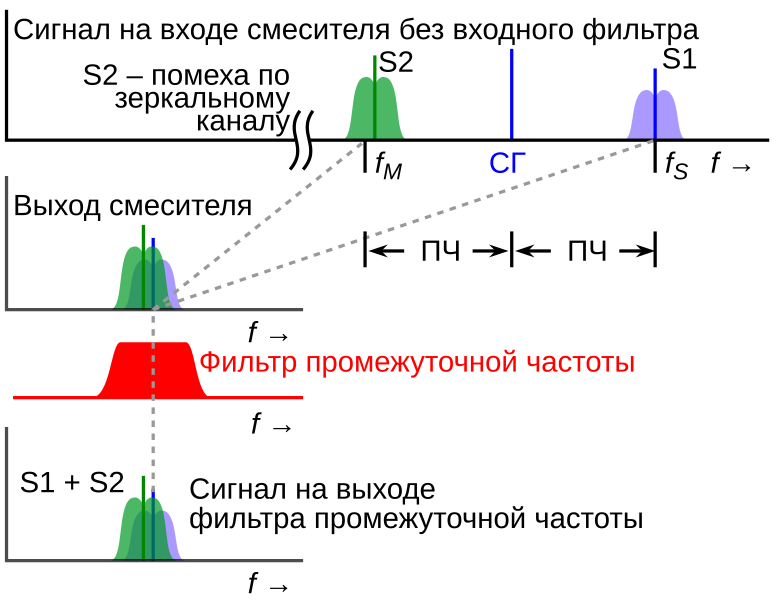File:Superheterodyne image problem-ru.svg

Original file (SVG file, nominally 847 × 652 pixels, file size: 2 KB)
Captions
Captions
Summary[edit]
| DescriptionSuperheterodyne image problem-ru.svg |
English: Diagram of the radio signals at different points in a superheterodyne radio receiver showing the problem of image response and why the receiver needs an RF image filter on the input. The horizontal axis is frequency while the vertical axis is voltage. The diagrams show what would happen in a superheterodyne without an RF filter.
In the superheterodyne the signal of the desired radio station (S1, blue) at frequency Русский: Графики радиосигналов в разных точках супергетеродинного радиоприемника иллюстрирующие возникновение и прохождение по тракту помехи с зеркальной частотой и поясняющая почему приемнику обычно необходим входной радиочастотный фильтр. По горизонтальной осотложена частота сигналов, а вертикальная ось — напряжение, или на красном графике коэффициент передачи фильтра в зависимости от частоты. На диаграммах показано влияние помехи по зеркальному каналу в супергетеродине без входного фильтра. В супергетеродине сигнал нужной радиостанции (S1, синий) на частоте  присутствует сигнал (S2, зеленый), он будет смещён на частоту ПЧ относительно частоты гетеродина и пройдет через фильтр ПЧ вместе с полезным сигналом S1 (нижний график), создавая помехи для него. Таким образом, супергетеродинные радиоприемники обычно должны иметь полосовой фильтр, называемый «ВЧ-фильтр», до смесителя, чтобы подавить мешающие сигналы на зеркальной частоте. В примере на рисунке частота сигнала S2 показана немного смещённой выше зеркальной частоты, поэтому при смещении его на промежуточную частоту, она не точно совпадает с полезным сигналом SI, из-за чего эти два сигнала почти сливаются на графике. присутствует сигнал (S2, зеленый), он будет смещён на частоту ПЧ относительно частоты гетеродина и пройдет через фильтр ПЧ вместе с полезным сигналом S1 (нижний график), создавая помехи для него. Таким образом, супергетеродинные радиоприемники обычно должны иметь полосовой фильтр, называемый «ВЧ-фильтр», до смесителя, чтобы подавить мешающие сигналы на зеркальной частоте. В примере на рисунке частота сигнала S2 показана немного смещённой выше зеркальной частоты, поэтому при смещении его на промежуточную частоту, она не точно совпадает с полезным сигналом SI, из-за чего эти два сигнала почти сливаются на графике. |
| Date | |
| Source | File:Superheterodyne image problem.svg by Chetvorno |
| Author | Д.Ильин: translation, optimization |
| Other versions |
|
| This SVG file contains embedded text that can be translated into your language, using any capable SVG editor, text editor or the SVG Translate tool. For more information see: About translating SVG files. |
Licensing[edit]
| This file is made available under the Creative Commons CC0 1.0 Universal Public Domain Dedication. | |
| The person who associated a work with this deed has dedicated the work to the public domain by waiving all of their rights to the work worldwide under copyright law, including all related and neighboring rights, to the extent allowed by law. You can copy, modify, distribute and perform the work, even for commercial purposes, all without asking permission.
http://creativecommons.org/publicdomain/zero/1.0/deed.enCC0Creative Commons Zero, Public Domain Dedicationfalsefalse |
File history
Click on a date/time to view the file as it appeared at that time.
| Date/Time | Thumbnail | Dimensions | User | Comment | |
|---|---|---|---|---|---|
| current | 17:09, 6 May 2023 |  | 847 × 652 (2 KB) | Д.Ильин (talk | contribs) |
You cannot overwrite this file.
File usage on Commons
The following 3 pages use this file:
File usage on other wikis
The following other wikis use this file:
- Usage on ru.wikipedia.org
Metadata
This file contains additional information such as Exif metadata which may have been added by the digital camera, scanner, or software program used to create or digitize it. If the file has been modified from its original state, some details such as the timestamp may not fully reflect those of the original file. The timestamp is only as accurate as the clock in the camera, and it may be completely wrong.
| Width | 239mm |
|---|---|
| Height | 184mm |












